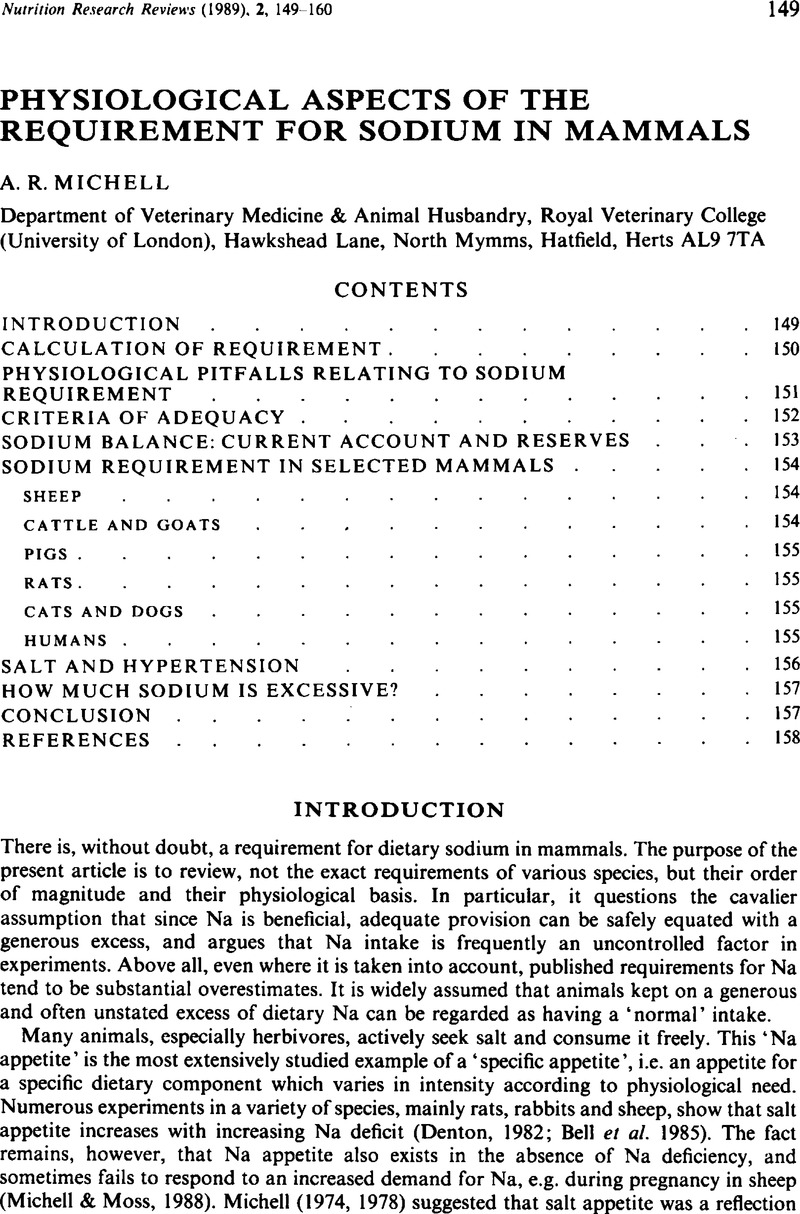Crossref Citations
This article has been cited by the following publications. This list is generated based on data provided by Crossref.
Vincent, I.C.
Michell, A.R.
and
Leahy, R.A.
1993.
Non-invasive measurement of arterial blood pressure in dogs: a potential indicator for the identification of stress.
Research in Veterinary Science,
Vol. 54,
Issue. 2,
p.
195.
Michell, A R
1994.
Salt, hypertension and renal disease: comparative medicine, models and real diseases.
Postgraduate Medical Journal,
Vol. 70,
Issue. 828,
p.
686.
Michell, A. R.
1994.
Comparative Clinical Nutrition of Sodium Intake: Lessons from Animals.
Journal of Nutritional Medicine,
Vol. 4,
Issue. 3,
p.
363.
1995.
The Clinical Biology of Sodium.
p.
295.
Bodey, A. R.
and
Michell, A. R.
1996.
Epidemiological study of blood Sressure in omestic dogs.
Journal of Small Animal Practice,
Vol. 37,
Issue. 3,
p.
116.
Bodey, A. R.
and
Sansom, J.
1998.
Epidemiological study of blood pressure in domestic cats.
Journal of Small Animal Practice,
Vol. 39,
Issue. 12,
p.
567.
Michell, A.R.
2003.
Encyclopedia of Food Sciences and Nutrition.
p.
5342.
Bonagura, John D.
Lehmkuhl, Linda B.
and
de Morais, Helio Autran
2006.
Fluid, Electrolyte, and Acid-Base Disorders in Small Animal Practice.
p.
490.
Park, Jae N.
Hwang, Keum T.
Kim, Sook B.
and
Kim, Sung Z.
2009.
Partial replacement of NaCl by KCl in salted mackerel (Scomber japonicus) fillet products: effect on sensory acceptance and lipid oxidation.
International Journal of Food Science & Technology,
Vol. 44,
Issue. 8,
p.
1572.
2009.
Food and Western Disease.
p.
250.
Leshem, M.
2011.
Low dietary sodium is anxiogenic in rats.
Physiology & Behavior,
Vol. 103,
Issue. 5,
p.
453.
Drake-Holland, A. J.
and
Noble, M. I. M.
2011.
Should we now abandon the low-salt diet?.
QJM,
Vol. 104,
Issue. 12,
p.
1103.
Whelton, Paul K.
Appel, Lawrence J.
Sacco, Ralph L.
Anderson, Cheryl A.M.
Antman, Elliott M.
Campbell, Norman
Dunbar, Sandra B.
Frohlich, Edward D.
Hall, John E.
Jessup, Mariell
Labarthe, Darwin R.
MacGregor, Graham A.
Sacks, Frank M.
Stamler, Jeremiah
Vafiadis, Dorothea K.
and
Van Horn, Linda V.
2012.
Sodium, Blood Pressure, and Cardiovascular Disease.
Circulation,
Vol. 126,
Issue. 24,
p.
2880.
Bonagura, John D.
Lehmkuhl, Linda B.
and
Autran de Morais, Helio
2012.
Fluid, Electrolyte, and Acid-Base Disorders in Small Animal Practice.
p.
514.
O'Donnell, M.J.
Mente, A.
Smyth, A.
and
Yusuf, S.
2013.
Salt intake and cardiovascular disease: why are the data inconsistent?.
European Heart Journal,
Vol. 34,
Issue. 14,
p.
1034.
Yao, Hiroshi
Nabika, Toru
and
Karamyan, Vardan
2014.
Excess Salt Increases Infarct Size Produced by Photothrombotic Distal Middle Cerebral Artery Occlusion in Spontaneously Hypertensive Rats.
PLoS ONE,
Vol. 9,
Issue. 5,
p.
e97109.
O’Donnell, Martin
Mente, Andrew
and
Yusuf, Salim
2014.
Evidence Relating Sodium Intake to Blood Pressure and CVD.
Current Cardiology Reports,
Vol. 16,
Issue. 10,
Mente, Andrew
O'Donnell, Martin J.
and
Yusuf, Salim
2014.
The Population Risks of Dietary Salt Excess Are Exaggerated.
Canadian Journal of Cardiology,
Vol. 30,
Issue. 5,
p.
507.
Drake-Holland, Angela J.
and
Noble, Mark I. M.
2016.
The Hyponatremia Epidemic: A Frontier Too Far?.
Frontiers in Cardiovascular Medicine,
Vol. 3,
Issue. ,
Bodri, Michael S.
2018.
Puddling Behavior of Temperate Butterflies: Preference for Urine of Specific Mammals?.
Journal of the Lepidopterists' Society,
Vol. 72,
Issue. 2,
p.
116.



